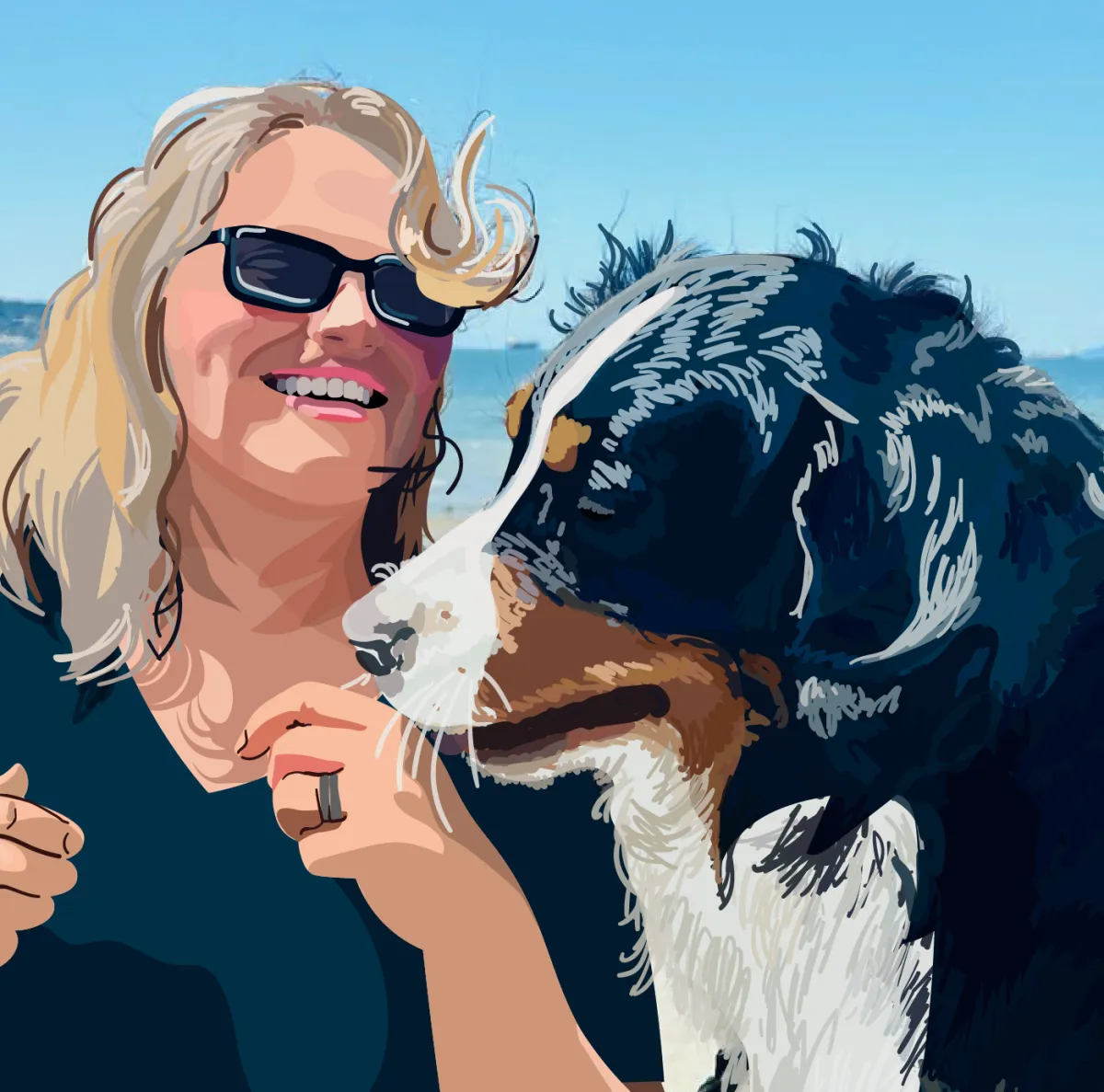

About Us
Since 2011, we’ve combined formal education in psychology, veterinary care, and canine cognition to provide exceptional training.
As an SPCA Accredited AnimalKind organization, we rely on the latest research, while ensuring that our work is rooted in 15,000 years of human-dog connection.
Dogs and humans have evolved together for 20,000 years. They have found food for us, and protected our families and livestock. They have gone to war with us and acted as gentle playmates for our children. They have laid down their lives to save us.
Our lifestyles have changed a lot in the last century, but our need for dogs hasn't. A dog and their owner, when reunited, sync their heart rates within minutes. Just owning a dog decreases heart attack mortality by 30%.
We are designed to live with dogs, but we need to learn how to incorporate them into our chaotic modern lives.
We're here to help your dog become a helpful and contributing member of your modern family.
Forget sit and stay!
At Wag The Dog we can teach dogs to:
Find our phones and keys when we lose them.
Find our children when we lose them!
Put recycling in the blue bin.
Fetch their own leash for walks.
Comfort us when we are sad or stressed.
Close doors and cupboards.
Imitate our actions.
Communicate their needs and thoughts clearly.
Recognize fragile people like children and the elderly and be cautious around them.
Assist us with our disabilities
Accompany us on outings to stores and markets.
Trust us to return home to them when we go out.
Understand simple phrases and two step instructions.

Carol Millman (she/her)
- Lower Mainland
B.Sc, Psychology, Veterinary Technologist, Certified Pet Dog Trainer - Knowledge Assessed (2022), Certified Trick Dog Instructor
Carol lives in Port Coquitlam and works in the Lower Mainland. Her autism gives her a unique perspective which she brings to her work with both dogs and people. Her time working as a veterinary nurse culminated in becoming the Director of Medical Services at a holistic veterinary clinic.
In 2008, Carol was hired as an apprentice Advanced Instructor at Pacific Assistance Dogs Society (PADS). She trained and placed wheelchair assistance dogs, hearing dogs for the Deaf, and facility therapy dogs. She also ran puppy classes and assisted in the daily care of the dogs in training.
PADS still sends people Carol's way when they are looking for private service dog training.

- Currently On Leave -
Amelia Kellum (she/her) - Fraser Valley
B.Sc Canine Studies, Certified Professional Dog Trainer Knowledge/Skills Assessed (2022), Certified Trick Dog Instructor.
Amelia is a certified professional dog trainer with nearly two decades of experience training dogs - including hunting, acting, and assistance dogs such as hearing, therapy, guide, and mobility dogs.
Amelia has learned directly from Bonnie Bergin, pioneer of the disability assistance dog, and is also a graduate of the Ben Kersen and the Wonderdogs professional trainer's program.
She apprenticed at PADS as an instructor and has been training independently since 2010. She now lives in Hope with her family.
What can you achieve
with our help?
Come check out our blog!

Let's Teach Dogs Instead of Training Them
It wasn't funny when it happened, but my clients were laughing by the time they told me the story. Their dog had escaped from the vet on neuter day, and taken off for home. The poor vet tech who followed him huffing and puffing halfway up a mountain toward the owner's house said she couldn't believe it - on multiple occasions the dog had stopped at cross walks, waited for traffic to stop, then carried on across the road, often before the tech could get there, and now separated from her by traffic.
She was amazed he hadn't been run over, and even more amazed that he had aimed for cross walks each time.
But it wasn't a coincidence... we taught him to do that.
Teaching Is Different From Training
Why do we "train" dogs? Why don't we "teach" them?
This isn't just about of the words we use. This is a mindset, and when we switch from training to teaching, dogs astound us with their capacity to understand.
When I criticize the use of compulsion in dog training, the come-back is usually somewhere along the lines of "it's for their own good". Dogs, these folks argue, aren't able to make their own decisions or care for themselves, so we must keep them obedient to us- for their own protection.
The assumption that people make when they say things like this is that dogs are not capable of caring for themselves. Dogs have to be leashed and constrained for their own safety! Otherwise they'd run away and get run over by cars.
And yet, that belief is fundamentally wrong. Dogs across the globe - in fact the vast majority of the world's dogs - are masters of their own fate and live in urban environments.
Go to any country with a large stray dog population and you'll find them waiting for the lights to change and crossing at zebra crossings just like the people around them.
These dogs weren't born knowing how to survive - they learned by watching their mother and other dogs - not to mention humans - and taking responsibility for their own survival.
A man on Bluesky last week - whose profile boasted that he liked conversations with non-dogmatic thinkers - told me "when zero dogs get hit by cars I'll believe dogs are capable of thinking for themselves".
I answered, "when zero humans get hit by cars I'll believe humans are capable of being thinking for themselves."
He blocked me after that. I guess I was too dogmatic.
Many e-collar trainers boast that with the help of "electrical stimulation" dogs can have MORE freedom because they can be trained to avoid the road, obey their owner more promptly etc.
But I get this same result just by... teaching the dog about roads and how to be safe.
What's The Difference?
Let's think about how we use the words "training" as opposed to "teaching".
"Teaching" is something we usually seek voluntarily or even pay for, whereas being "trained" is something that is normally done TO us by employers.
If someone wants to learn how to do something, or understand a concept better, they seek out a teacher. If someone is hired to do something, they get trained.
When we train somebody, we say "do this". We train someone on how to process a transaction on the cash register, or how to enter a new patient into the computer system. There isn't a lot of philosophy involved.
Training is a do-it-this-way-not-that-way sort of a process.
By and large, that also describes how we usually work with dogs.
"When I say sit, put your butt on the ground. Do it fast and well and you'll get a treat. If you don't do it, you won't get a treat."
Depending on what kind of a trainer is speaking, they might add, "and if you don't do it, I'll jerk your leash/refuse to move until you do" or "if you don't do it, I'll put the treats away".
We train dogs to put their butt here, stop when we say so, and return to us on cue.
There's no reason, no explanation, no justification involved.
Even with positive reinforcement, the motivation is "I'll give you a cookie" but the reason is "because I gave the cue".
But when we teach someone, we explain.
We ask them to think and we give background. We quiz them, question them, and give them opportunities to show that they understand what we have taught.
Training is about what to do when.
Teaching involves explaining why and how.
Both kinds of learning are valuable in the right situation.
After all, I don't need to learn the history of the cash register in order to take a fast food order. I don't need to understand data bases, the various kinds and how they organize their data, to input that data. I just need to know the steps to enter it into THIS database.
If all you want is for me to perform the allotted task, training is fine.
Drilling a child on their times tables is more like training. Helping them develop an understanding of numbers and how they work is more like teaching.
If all we want is for dogs to stop at curbs, training them to do so is fine. But is that really all we want?
What if dogs actually understood?
Let's look at teaching the concept of "wait".
We train dogs to wait at the door so they don't bolt out into the road. We have a REALLY good reason for this.
The saddest drive I ever took was with a little lab puppy in the passenger seat, dead and stiff. The puppy had run out into the road. An SUV was coming. There was ice on the road.
The owners were too nervous to drive, so when they called the vet where I worked at the time, I volunteered to go to them and get the puppy. It was dead by the time I got there.
We train dogs to sit at street corners so they don't step into the road too early, for the same reason. We don't want them dead. I am a big proponent of teaching dogs to wait at doorways and curbs.
But I don't just TRAIN them to do it. I TEACH them about cars and the dangers of the road so they can understand WHY they should stop.
Dogs are quite capable of understanding the danger of cars. Guide dogs have been saving their blind handlers from errant cars for a hundred years.
Guide dog training is often more like teaching
While we usually say that guide and service dogs are "trained", it is much more like teaching than traditional "training".
The dog is "trained" go to forward in a straight line when told to go forward - but then taught to think for themselves before they actually obey.
Guide dogs are taught that their handler will blithely walk out in front of cars, walk into telephone poles, and trip over breaks in the sidewalk... and the dog must take this into consideration before actually doing what they were told.
Not only is the dog expected to think before they obey, they have to analyze the situation and take into account their human's height and width: If there is a barrier low enough for the dog to pass under, or narrow enough for the dog to pass through on their own, they must recognize that their human will still whack into it and therefore they should not move.
The trainers can't know every situation a dog may end up in over their working life. Instead the dogs have to understand - understand the height of their person, the width of their person, and consider routes before going forward.
Guide dogs are taught to do many other things - find a coffee shop, find a door, locate a police officer, find escalators and elevators, locate bathrooms or exits, or to take their person home.
People think this is because guide dogs are very smart. But actually, service dog schools don't pay much attention to doggy IQ in their breeding programs - they focus on breeding confident, calm, patient dogs.
The intelligence is taught, not bred.
Teaching starts in childhood.
...I mean, puppyhood.
While any dog, just like any person, can learn new things in adulthood and even old age, puppyhood is a time when the brain is very flexible and makes new connections very fast.
Puppies who are taught rather than trained end up better able to think for themselves, control their own behavior, and make good decisions than puppies who were only trained. They end up "smarter" than "because-I-said-so" puppies.
A dog raised on "training" will do what they feel like unless specifically instructed otherwise, or will anxiously wait to be told how to handle any situation because they don't understand the world they live in.
A dog who is taught, on the other hand, can learn incredible things.
Here's a short list of some of the things dogs can understand:
Watch the traffic then decide when it is safe to cross.
Retrace their steps to find home.
Recognize when someone is fragile and be extra gentle with them.
Develop a concept of "phone" or "hat" and seek out and identify one even if it is not identical to the ones they have seen before.
Find a complete stranger hidden in a new location, because they understand that they are asked to seek a particular scent and know how to disregard irrelevant scents.
Identify not only when their person's blood sugar is high, but when it is rising and anticipating when it will become high in the near future.
Anticipate when a person will soon have a migraine, psychotic episode, or seizure even though medical science still hasn't figured out a way to do so.
Locate a concept such as "stairs" or "door" in a brand new location and take someone to it.
Watch a human perform an action and copy that action.
Learn how to operate a simple machine with easy-to-press buttons or levers... including a CAR.
Count up to at least 4 or 5, and do simple addition and subtraction.
Recognize and identify shapes.
Recognize and identify colours.
Recognize and identify letters and spell their own name.
Sort objects by type. big vs small, toy vs laundry, round vs square.
Recognize and identify photos of familiar people.
Communicate in three and four word sentences using buttons or cue cards.
Honestly, I could go on and on. The list of things dogs cannot do seems to be a much shorter one:
Dogs seem to struggle with basic physics, including gravity.
Their spatial skills are limited. While most dogs can eventually learn to unwind themselves from a pole, they can only do it if a 360 successfully unwinds them. If the leash is wrapped around twice they get stumped.
They also struggle with logic tasks, and are easily baffled by simple magic tricks... at least until they use their nose to figure out where the treat went.
They don't have opposable thumbs and do not excel at tasks involving fine motor control.
We humans are definitely the scientists of the family.
Dogs will never invent a device or understand how cars work, but honestly the same goes for me, so I won't judge them for that.
Ultimately, though, dogs understand and are capable of far more than the average person gives them credit for. When we teach them and assume that they are capable of learning and understanding, we get safer, calmer, more reliable dogs. \
So the next time you struggle with your dog's behaviour, ask yourself: "Have I taught my dog the reason for this rule, rather than demanding it be arbitrarily followed?"
Then give it a try.

We work on land which was taken from the nations who had lived here for thousands of years. They are still here and they are still waiting patiently for us to stop being jerks about it.
© 2024 Copyright Wag The Dog Training
All Rights Reserved




